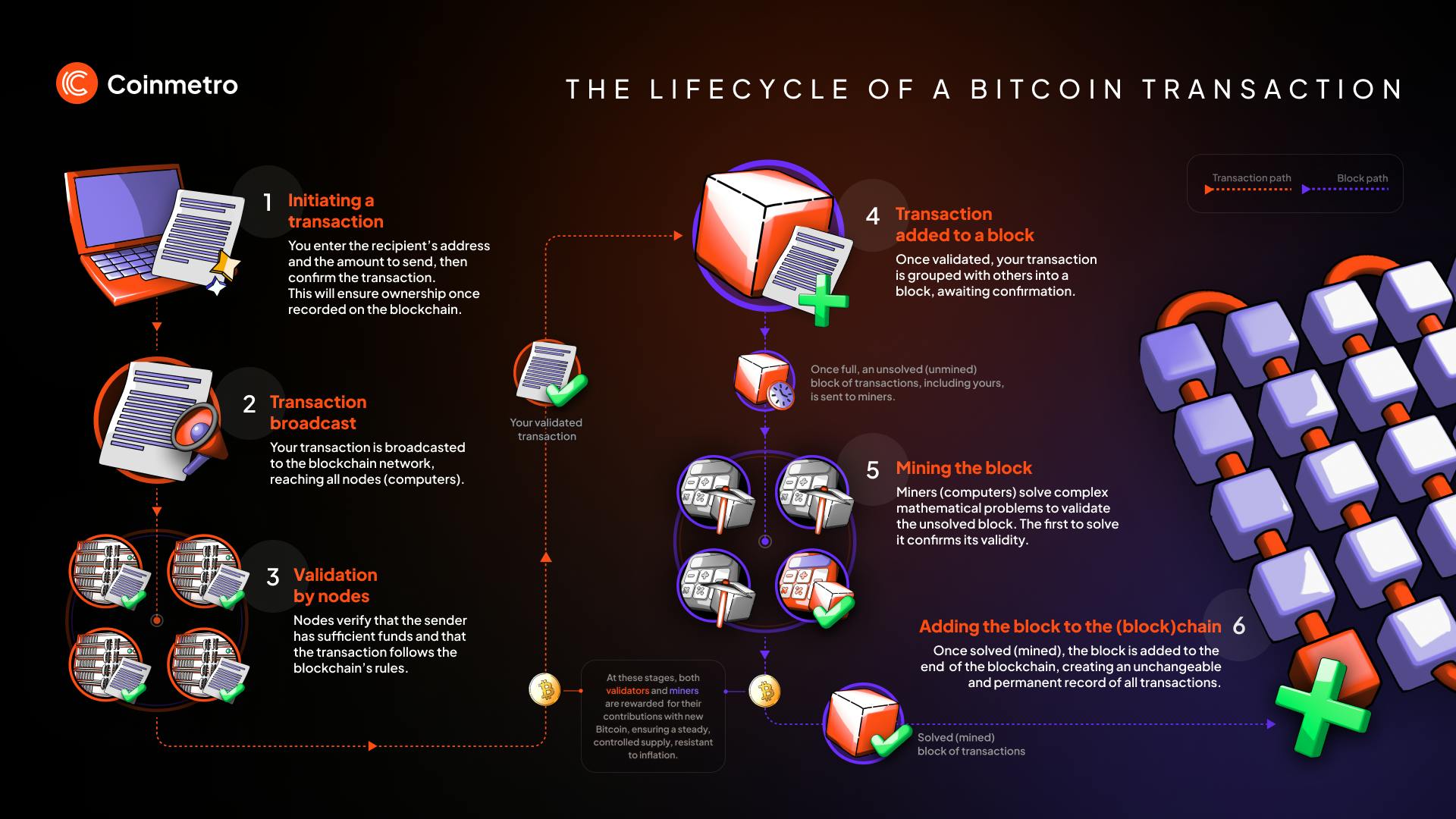Choosing the Right Crypto Mining Rig for Bitcoin and Altcoins in 2025
December 5, 2025

by Coinmetro Editorial Team
December 5, 2025
Crypto mining powers blockchain networks by validating transactions and earning rewards. In 2025, it thrives despite shifting dynamics — Bitcoin’s halving squeezes margins while altcoins like Ethereum Classic and Kaspa gain traction. However, energy costs, regulatory scrutiny, and hardware shortages shape a complex landscape.
Choosing the right crypto mining rig matters more than ever. Profitability depends on efficiency, not just hash power, as electricity bills can erode gains. A mismatched setup risks losses in this competitive, capital-intensive field. Whether you mine solo, join a crypto mining pool or rent hashpower via cloud mining, your setup strategy directly affects your earnings, risk, and level of control.
This guide targets new miners, investors, home setups, and small-scale operations. It equips you with precise insights to navigate 2025’s crypto mining challenges. Whether chasing Bitcoin or altcoin rewards, your rig defines success. Now… grab your virtual pickaxe, and let’s “dig” for digital gold! ⛏️
This blog will outline:
- Understanding crypto mining rigs
- Key factors for choosing a crypto mining rig
- Best Bitcoin mining rigs in 2025
- Joining a crypto mining pool in 2025
- Cloud mining vs physical rigs
A crypto mining rig is a specialized hardware that solves complex blockchain algorithms. It earns crypto rewards by validating transactions. Two main types dominate: ASICs and GPUs. Application-Specific Integrated Circuits (ASICs) target one algorithm with unmatched efficiency. Graphics Processing Units (GPUs) offer flexibility across multiple coins. Hardware-software synergy drives performance. Efficient rigs pair optimized firmware with robust cooling. Poor integration can waste energy and cut profits.
Bitcoin uses SHA-256, a proof-of-work algorithm favoring raw computational power. Altcoins deploy varied algorithms—Ethash for Ethereum Classic, KawPow for Ravencoin. Each demands specific hardware for optimal output.
ASICs excel in Bitcoin mining, delivering high hash rates for SHA-256. GPUs suit altcoins, adapting to diverse algorithms like Scrypt or Equihash. Your choice shapes profitability in 2025’s volatile market.
Your crypto mining rig must align with the coin you target. As mentioned, Bitcoin relies on SHA-256, a proof-of-work standard, while altcoins like Kaspa use kHeavyHash. Picking the wrong hardware wastes time and money, so precision matters.
Resources like WhatToMine or CoinWarz detail algorithm support for various coins. These tools help you match rigs to blockchains. Start here to avoid costly errors in 2025’s fast-evolving market.
Hashrate shows how fast a rig solves cryptographic puzzles. Yet, raw speed alone doesn’t guarantee profits — efficiency defines the real winner. Look at performance-per-watt metrics, such as J/TH for ASICs or MH/W for GPUs.
In 2025, rising energy costs can punish inefficient setups. A high-hash rig that guzzles power can potentially drain your returns. Prioritize balance over brute force for sustainable crypto mining.
Crypto mining rigs devour electricity, and that bill shapes your bottom line. A 1,000-watt ASIC might churn out hashpower, but profitability shrinks if power costs exceed rewards. Your local electricity rates dictate the equation.
Estimate expenses with your kWh price—say, $0.15 in California versus $0.05 in Texas. Check utility tariffs regularly, as fluctuations hit hard in competitive crypto mining.
Glossary Deep Dive: How Crypto Mining Pools Work — Advantages & Considerations
A rig’s price tag sets the stage for your investment. GPUs start around $1,200, while top-tier ASICs hit $12,000 in 2025’s supply-constrained market. You need to weigh this against potential earnings.
ROI depends on coin prices, network difficulty, and luck. Calculators from NiceHash or CryptoCompare project break-even points — think 10 months for a $5,000 rig at current Bitcoin rates.
ASICs pump out heat and noise, often exceeding 80 decibels. GPUs run cooler and quieter, but still demand ventilation. Overheating slashes efficiency and can damage components.
Home miners should factor in living conditions. A basement setup might handle an ASIC’s thermal load, but apartment dwellers may prefer GPUs for sanity’s sake.
GPU rigs offer modular growth — snap in more cards as funds allow. ASICs, built for one algorithm, lack that flexibility, locking you into a coin’s fate. Scalability suits altcoin miners chasing trends.
Resale value varies too. GPUs appeal to gamers and miners alike, while ASICs tied to fading coins lose demand fast — plan ahead for 2025’s shifts.
Explore Cryptocurrency Sustainability: Impact of Crypto on the Environment

The Bitmain Antminer S21 delivers a hashrate of 200 TH/s with a power draw of 3,500 watts. Its efficiency, at 17.5 J/TH, suits high-output operations despite rising energy costs. Miners prize its hydro-cooling option, which boosts longevity.
Pros: Top-tier performance and reliability
Cons: High cost and noise levels above 75 decibels.
Best for industrial and large-scale miners, it thrives in setups prioritizing raw power over budget constraints.
The WhatsMiner M60S offers 186 TH/s, consuming 3,441 watts with an efficiency of 18.5 J/TH, using air cooling. The M66, hydro-cooled, hits 298 TH/s at 5,513 watts, achieving 18.5 J/TH. Both excel in commercial-grade Bitcoin mining.
Pros: Feature robust hashrates and cooling options
Cons: Steep prices and power demands.
Serious commercial operations benefit most, leveraging scale to offset costs in 2025’s competitive landscape.
Canaan’s AvalonMiner A1466 provides 170 TH/s, drawing 3,315 watts with a solid 19.5 J/TH efficiency. Known for stability, it withstands prolonged use without frequent maintenance. Its air-cooled design balances performance and cost.
Pros: Durability and value
Cons: A lower hashrate versus rivals.
Best for miners seeking balanced performance and value, it fits mid-tier operations well.
Bitaxe, an open-source mining rig, lets enthusiasts build custom setups. It uses chips like BM1397 (up to 700 GH/s) or BM1398, with power consumption around 15-20 watts. Hashrates vary by configuration, ideal for experimentation.
Pros: Flexibility and low entry cost
Cons: Modest output and assembly complexity.
DIY miners, learners, and developers thrive with Bitaxe, exploring blockchain tech hands-on in 2025.
SEC Confirms: Proof-of-Work Crypto Mining Doesn’t Trigger Securities Laws
If you own your own ASIC or GPU mining rig, joining a crypto mining pool can often be a smart way to earn consistent payouts. Crypto mining pools combine the hashrate of thousands of miners, increasing the odds of block rewards and distributing profits proportionally based on contribution. Most pools use payout models like PPS+ (Pay-Per-Share Plus), which offers stable rewards per share plus a cut of transaction fees, or PPLNS (Pay-Per-Last-N-Shares), which rewards miners based on recent activity only when a block is found — offering higher long-term potential but more variability. Here are five popular crypto mining pools in 2025:
ViaBTC
Supports: Bitcoin, Bitcoin Cash, Litecoin, and others
Payout methods: PPS+, PPLNS
Features: Low fees, real-time monitoring, merged mining (BTC+NMC)
Best for: Miners seeking stable payouts and extra Namecoin rewards
F2Pool
Supports: BTC, ETHW, LTC, ZEC, and many altcoins
Payout methods: PPS+
Features: One of the oldest pools; great UI; multilingual support
Best for: Diverse altcoin and Bitcoin miners wanting flexibility
Luxor
Supports: BTC, Kaspa, LTC, and more
Payout methods: FPPS, PPS
Features: U.S.-based; excellent API tools and transparency
Best for: Professional miners and institutions seeking reliability
CKPool (solo.ckpool.org)
Supports: Bitcoin solo mining
Payout methods: Block reward only (solo mining)
Features: Ideal for solo mining experiments with low hashrate rigs (like Bitaxe)
Best for: Hobbyists or risk-takers looking for a full block reward lottery
Slush Pool (now Braiins Pool)
Supports: Bitcoin
Payout methods: Score-based
Features: First-ever crypto mining pool; great transparency and Braiins OS+ support
Best for: Bitcoin miners who value decentralization and transparency
Opinion: Can Bitcoin Mining Increase Renewable Electricity Capacity?
When joining a crypto mining pool, it’s crucial to understand how you’ll get paid. The two most common payout methods — PPS+ and PPLNS — offer different trade-offs between stability and potential reward.
PPS+ (Pay-Per-Share Plus): You get a fixed payout for every valid share you submit, regardless of whether the pool finds a block. Plus, you also get a portion of the transaction fees from blocks the pool successfully mines.
Pros: Stable, predictable income
Cons: Slightly higher pool fees
PPLNS (Pay-Per-Last-N-Shares): You get paid only when the pool finds a block, and your reward is based on your share of work in the last N shares submitted.
Pros: Lower pool fees, better long-term rewards if you stay consistent
Cons: Income fluctuates depending on block luck and your recent activity
Cloud mining is a service where you rent computing power from a remote data center to mine cryptocurrency without owning physical hardware. This may suit those avoiding hardware hassles. It skips the need for costly rigs, technical setup, or soaring electricity bills—ideal for beginners or small investors.
In 2025, with Bitcoin’s difficulty spiking, renting hashpower can offer a quick entry without long-term commitment. Consider it if you lack space or expertise. Some providers can handle maintenance, letting you focus on returns. It’s a low-barrier option when physical rigs feel impractical.
Cloud mining carries risks — potential scams plague the sector, promising high yields but vanishing with funds. Legit platforms still face volatility; Bitcoin’s price swings and rising difficulty can slash ROI below physical rigs’ potential. Physical setups, while pricier upfront — think $5,000 for an Antminer S21 — offer control and higher long-term gains, often 20-30% annually versus cloud’s 10-15%.
Energy costs can hit physical miners harder, but cloud contracts lock you into fees that may erode profits if mining difficulty climbs. Scams aside, physical rigs typically outpace cloud ROI after 12-18 months, assuming stable power rates.
Here are five reputable, safe cloud mining platforms for 2025:
ECOS: Based in Armenia’s Free Economic Zone, ECOS enjoys tax-free status and legal backing. It provides Bitcoin contracts from $150, with daily payouts and SSL-secured reliability. Newcomers prize its regulated, trustworthy framework.
Genesis Mining: Since 2013, Genesis has served over two million users worldwide. It covers Bitcoin and altcoins like Ethereum, offering flexible plans with no surprise fees. Its proven track record ensures safety for consistent miners.
BeMine: Starting in 2018, BeMine sells fractional ASIC shares, slashing upfront costs. Operating from Kazakhstan and Russia, it delivers clear payouts and live monitoring. Budget-savvy investors value its transparency and control.
NiceHash: NiceHash runs a hashpower marketplace, not classic cloud mining. You lease power globally, targeting Bitcoin or altcoins with no fixed contracts—2FA bolsters security. It suits cautious miners craving flexibility.
Bitdeer: Founded in 2018 by ex-Bitmain execs, Bitdeer taps data centers across the U.S. and Norway. It offers Bitcoin and altcoin plans, with scalable hashpower and uptime above 99%. Serious miners favor its professional-grade infrastructure.
Crypto mining in 2025 demands sharp decisions. Bitcoin’s halving and altcoin surges reshape rewards while energy costs and hardware scarcity test profitability. Your rig — whether an ASIC powerhouse, a GPU array, or a cloud contract — anchors your success in this volatile field.
Efficiency now trumps raw hashrate as margins tighten. Home miners weigh noise and heat, hobbyists tinker with Bitaxe, and industrial players chase scale with Antminers. Cloud mining tempts with ease, yet physical rigs offer control — choose wisely based on goals, budget, and risk tolerance.
This guide arms you with clarity for the year ahead. Pair the right hardware with solid research, from algorithm fit to ROI timelines. In a market where every watt and dollar counts, your strategy decides if you lose, survive, or thrive.
Join the Coinmetro community on Discord and Telegram, where forward-thinking traders and investors gather to share insights, explore new opportunities, and dive deep into cryptocurrencies. Should you need any help, please contact our world-class Customer Support Team via 24/7 live chat or email at hello@coinmetro.com.
To become a Coinmetro user today, Sign Up now or head to our new Exchange if you are already registered to experience our premium trading platform.
Tags
Related Articles

Regulatory Sandboxes: Fostering Crypto Innovation Within Legal Frameworks
The cryptocurrency industry’s fast rise fuels an important debate. Innovation aims to transform finance, enhancing speed and access. Yet, regulators…
5m

Crypto Options Trading: Strategies and Market Insights
Cryptocurrency markets have rapidly expanded beyond simple buying and selling. One of the most significant developments has been the rise of…
6m

The Rise of Social-Fi: Blending Social Media with Decentralized Finance
In recent years, social media and finance have started to merge, creating Social-Fi. This concept blends the engagement of social platforms with…
6m

DeFi Insurance Platforms to Watch in 2024
Decentralized Finance (DeFi) insurance addresses the growing need for insurance against hacks, smart contract failures, and other DeFi-related risks.…
7m